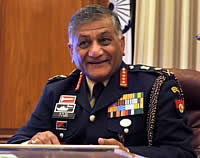Indian Army Chief: Nukes Not For Warfighting
 |
| Gen. V.K. Singh |
.
By Hans M. Kristensen
India’s nuclear weapons “are not for warfighting,” the chief of India’s army said Sunday at the Army Day Parade. The weapons have “a strategic capability and that is where it should end,” General V. K. Singh declared.
The rejection of nuclear warfighting ideas is a welcoming development in the debate over the role of nuclear weapons in South Asia. Pakistan’s military’s description of its new snort-range NASR missile as a “shoot and scoot…quick response system” has rightly raised concerns about the potential early use of nuclear weapons in a conflict.
NASR is one of several new nuclear weapon systems that are nearing deployment with warheads from a Pakistani stockpile that has nearly doubled since 2005.
India is also increasing its arsenal and already has short-range missiles with nuclear capability: the land-based Prithvi has been in operation for a decade, and a naval version (Dhanush) is under development. But India’s posture seems focused on getting its medium-range Agni II in operation, developing longer-range versions to target China, and building a limited submarine-based nuclear capability.
If Gen. Singh’s rejection of nuclear warfighting is reflected in India’s future nuclear posture, two important things will have been achieved: rejection of the mindless tit-for-tat philosophy that otherwise dominates nuclear posturing; and limiting the scenarios where nuclear weapons otherwise could come into use. The rejection also has importance for other nuclear weapon states, where some have called for making nuclear weapons more “tailored” to limited regional scenarios.
This publication was made possible by a grant from Carnegie Corporation of New York and Ploughshares Fund. The statements made and views expressed are solely the responsibility of the author.
While advanced Chinese language proficiency and cultural familiarity remain irreplaceable skills, they are neither necessary nor sufficient for successful open-source analysis on China’s nuclear forces.
Satellite imagery has long served as a tool for observing on-the-ground activity worldwide, and offers especially valuable insights into the operation, development, and physical features related to nuclear technology.
This report outlines a framework relying on “Cooperative Technical Means” for effective arms control verification based on remote sensing, avoiding on-site inspections but maintaining a level of transparency that allows for immediate detection of changes in nuclear posture or a significant build-up above agreed limits.
The grant comes from the Carnegie Corporation of New York (CCNY) to investigate, alongside The British American Security Information Council (BASIC), the associated impact on nuclear stability.